Snow Tails: A racing board game that plays like a puzzle
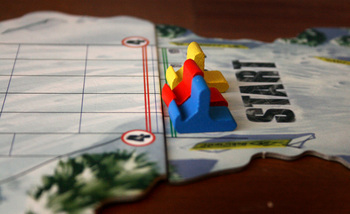
Mike Hulsebus | Contributor
Two weeks ago, we looked at Formula D, a racing game that involved rolling dice and taking risks to try and pull into the lead. Today we look at a different sort of racing game: Snow Tails. Snow Tails was designed by the Lamont Brothers, two guys known for making games with unique mechanics.
In Snow Tails, players design their own track with modular board pieces and then race their sled teams across it, trying to guide their team through obstacles and around turns. Where Formula D is a total dicefest, Snow Tails plays more like a puzzle. Let’s look at how the game plays to see if that’s a bad thing.
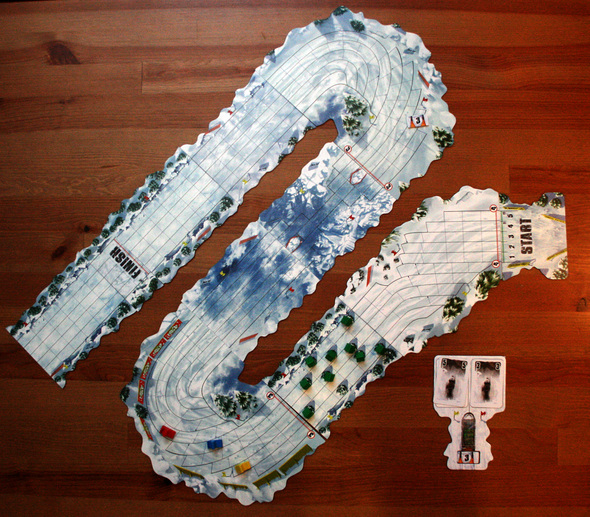
Mike Hulsebus | Contributor
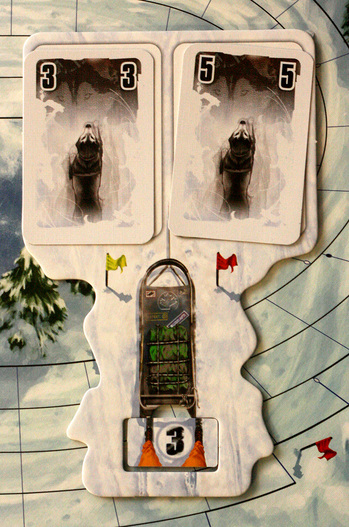
Mike Hulsebus | Contributor
Each player gets his own sled board that has a place for a brake token and two places to play cards. His sled is represented on the main map by a sled pawn in his color. To explain how movement works, let’s take a look at what happens in the instance pictured. To figure out how many spaces you move, you add up the sum of the cards on the front of your sled (eight in this case) and subtract the value of your brakes (three). That (five), is how many spaces you are going to be moving forward.
Also, the difference between the values of the dogs in the front of the sled dictates if the sled goes straight or drifts to one side. In this case, since the five side is pulling harder than the three side, the sled drifts over two spaces toward that side. Players use this drifting to guide their sleds around the track’s turns and to avoid the track’s obstacles.
Each player has a hand of five cards, and each turn he plays one and only one card to his sled to change one of the values of his sled. If he plays a card on his brakes, it changes the brakes to that value. So, for example, if you were to play a one card on the brakes, you would move seven spaces forward, two of them being to the right. Instead you might play a card onto the one of the front spaces on the sled of the sled to balance out your sled so that that you don’t go too far right and go off the course. After moving, the player draws back up to five cards.
If a player runs into something like a tree or another sled, he must take a damage card and add it to his hand. Damage cards do nothing but take up space in your hand, so the more damage that you rack up, the fewer numbered cards you’ll have to choose from on your turn.
Snow Tails is a quiet game. You’re going to spend a lot of time looking at each of your cards figuring out which of your cards is the best to play and the many ways that you could play it. Good players will be not only planning this turn’s move but also thinking about if they will have the right cards to do what they need to do next turn.
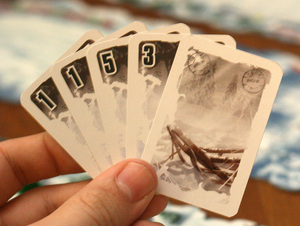
Damage cards (right) take up space in players' hands and leave them with fewer number cards to choose from to play on their sleds.
Mike Hulsebus | Contributor
If a player is taking too much time, the game comes with a Big Paws token to give that player — its purpose nothing other than to shame the player into making a decision. Despite how this makes the game sound, I haven’t had too much trouble with people taking an excessively long time picking a move since you can plan out your move during other players’ turns. Because of this, the game doesn’t get bogged down with analysis paralysis as you wait for someone to figure out the optimum move for three minutes, which is pretty rare in the genre of puzzle-like games.
I like the fact that this game allows you to make up your own tracks to dictate how long of a race you want to play and how difficult you want the race to be. So rather than playing the same race track every time, you get to have an experience that feels different each time. There isn’t a huge amount of variation in the track segment types, but each board is double-sided, and proximity to other pieces will dictate how hard different segments of track are — put a snow drift by a sharp turn and players will have to do some quick maneuvering.
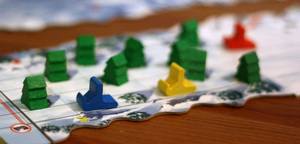
Mike Hulsebus | Contributor
Snow Tails would be good for someone who likes puzzle-like games or games with very little “take that” interaction. While I wouldn’t necessarily lump this in with ordinary, everyday “family games,” I do think this will appeal more to families than it does to gamers. I don’t even know that this will appeal to people who like race games; I don’t feel like I’m running a race when playing Snow Tails — more like I’m running an obstacle course with some bumbling clumsy robot, but I have no problem with that.
I recognize that this is a good game, but I also recognize that this just isn’t the game for me. I have fun playing it; it’s the sort of game that I’m always willing to play but would never suggest to play, making it disappear among my other game options. Unlike last week’s game, Red November, which I said was not different enough from other games to warrant a purchase, I do think that Snow Tails is inventive enough and replayable enough to be a great game for someone, but just not for me.
And so, having played it sparsely over the past few months, I recently traded away Snow Tails for Nuns on the Run, a game of stealthy sneaking that I’ll be sure to cover after I’ve played it enough to do a review.
Mike Hulsebus reviews board games on AnnArbor.com and can be reached at mikehulsebus@gmail.com. He current has no plans to review the 1990 movie, Nuns on the Run.

